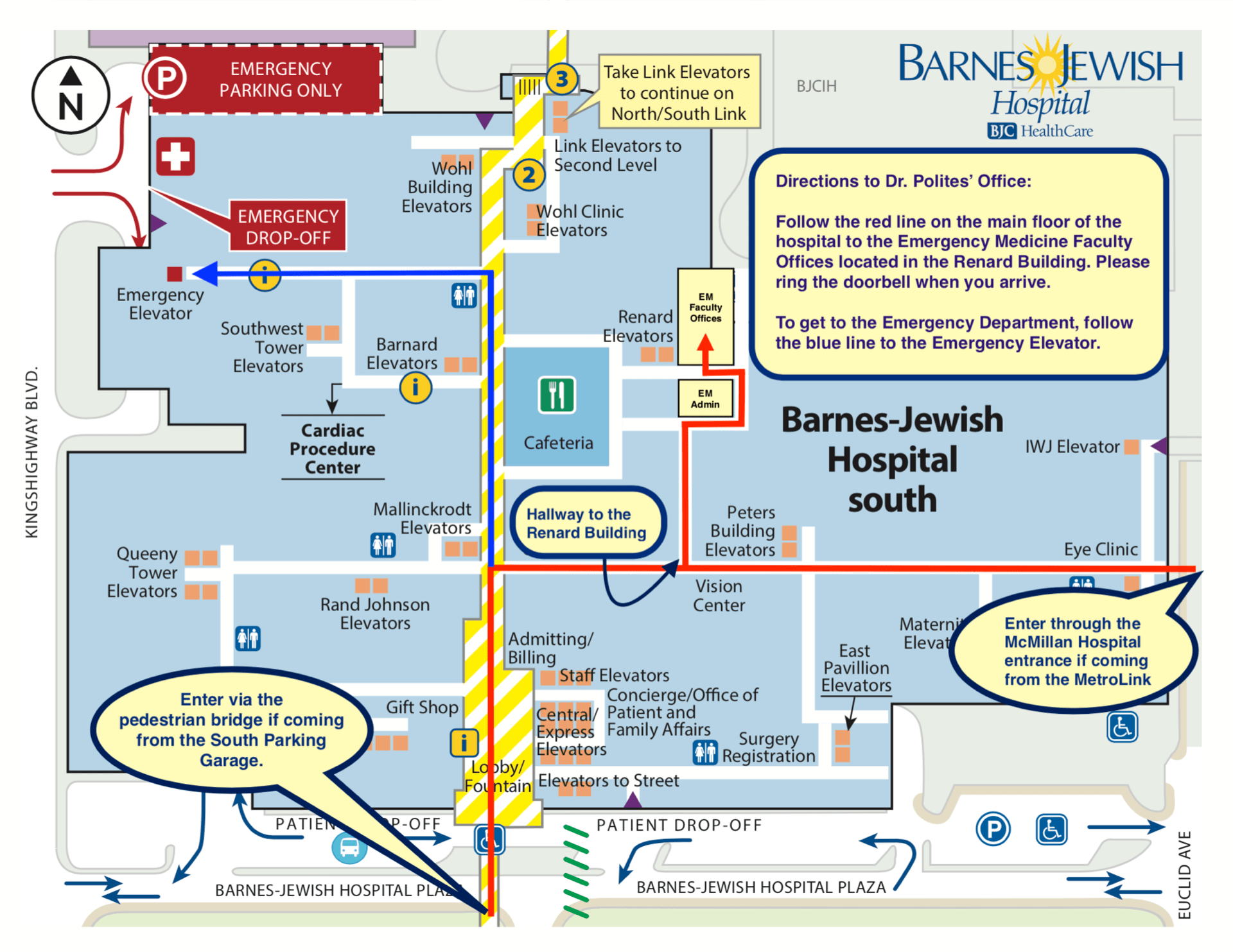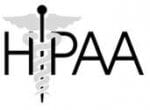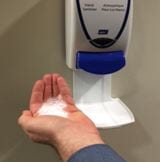Before You Shadow…
Please review the information below before you shadow.
After you arrive and place your things in the EM-1 workroom, you can then report to your assigned area and find a medical student to shadow. Don’t hesitate to go up and introduce yourself. The medical students and residents are very familiar with MedPrep students and will know you from your red shirt so there is no need to stand around feeling out of place. The atmosphere in the ED, while stressful at times, is actually quite relaxed when it comes to the personalities of the students, staff, and physicians. If a medical student is not on shift then you will shadow a resident. Given that new interns just started in July, you should try to find a 2nd, 3rd, or 4th year resident to shadow if a medical student is not available.
Make sure that you are not shadowing an attending (unless the attending invites you to do so).
During your shadowing shift you’ll follow your student (or resident) into every room. During class, you’ll be shown a place to stand in the TCC rooms when a major resuscitation is taking place (e.g. a Level 1 trauma or cardiac arrest). It’s best for you to simply go to that location if you hear a code or trauma is arriving because the room can get very crowded, very fast. Remember, however, that when the radiology tech comes in to take X-rays, you should get out of the room ASAP to avoid radiation exposure. You may bring food and drinks with you or may go to the cafeteria at any time. The cafeteria is located on the main floor. You must eat in the “Clean Room” (the physician work space) in EM-1 or EM-2 or in the cafeteria, but never at the counters in the ED or in the hallways.
Students coming to the medical campus by the MetroLink will get off at the Central West End stop. Once you come up the stairs (or take the elevator) to the street level, take a left and walk about a block. This is Euclid Ave. You will notice the hospital to your right. You will enter the hospital via the McMillan Hospital entrance. For a reference point, the Farrell Learning and Teaching Center (FLTC) is located just up a little on the left. The McMillan entrance is locked in the evening, however. In that case, walk up a little further and take a right at the corner. You can then enter through the street level main entrance, located across the street from the Plaza Garage. Late at night though, this entrance will be locked as well. In that case, go into the parking garage and take the escalator up to the lobby.
Regardless of the entrance you use, once inside the hospital, follow the map below.
If you are driving, you will park in the Plaza Garage located on Barnes-Jewish Hospital Plaza. This garage is directly in front of the hospital. You will take the escalator up to pedestrian bridge which leads to lobby of the hospital.
- Follow the blue line to the Emergency Department elevator (small red square on the map at the end of the blue arrow). It will take you into the waiting room of the E.D.
- If you have an in-person meeting with Dr. Polites, follow the red line to get to his office.

Things To Do
-
The first thing to do when you arrive is to make sure you are in the correct pod in the E.D. Are you assigned to shadow in EM-1, EM-2, or TCC?
-
Next thing to do is to introduce yourselves to the physicians and medical students in that pod. You will always shadow a medical student. If there is no medical student, then you will shadow an EM resident (but not an intern).
- Feel free to ask the your medical student or resident questions, but try to sense the appropriate time to do so. If you can tell that they look busy, hurried, preoccupied, consider saving your question for later. Give them some breathing room. There will be times when they may be doing nothing but charting. At that time, lay back a little. Also understand that sometimes they will be so busy that they may not give you much attention. Never take this personally. Remember, students are on an elective where they are trying to learn and also demonstrate a good performance so please try to interrupt them as little as possible. For residents, their job is hectic and they are always managing several sick patients at once, making it challenging for them to engage in conversation.
- Always feel free to follow your student or resident anywhere. They know that you are there to shadow, but they will not repeatedly ask you to follow them or keep up. If you get distracted talking with someone else you may notice that your student or resident is nowhere to be found.
- Please try to keep side talking down to a minimum. Often times you will be observing the resident presenting their patient history and exam to the attending. If you engage in conversation with the medical student while the resident is presenting to the attending, this can be very distracting. When the resident and attending begin discussing a patient, that’s when you want to make sure that you are paying attention and not talking.
- The student or resident you are shadowing will usually introduce you to the patient but if they fail to do so, feel free to introduce yourself if the situation is appropriate (i.e. the patient is alert, free of pain, etc). Follow the student or resident’s lead, however, on shaking hands. Some patients may be under “Contact Precautions” and may be harboring infectious organisms.
- ALWAYS use the alcohol hand foam (located on the wall outside the room) when entering AND exiting the room. Simply touching the counter or wall in the room can expose you to bacteria and viruses. It’s best to be safe and disinfect your hands frequently.
- Stay to your assigned area of the ED. This course is designed so that only one student will be in any one area of the ED during a shift. For this reason, you may only shadow in the area where you are scheduled. Shadowing with another student or in groups is also NOT allowed.
- Pay attention to everything. Sometimes students don’t realize that every situation can be a learning experience, from watching how the physicians and nurses interact to how our social workers help a patient or their family. If you are bored during a shift, it’s more than likely that you aren’t keeping your eyes open to everything around you.
- Wear your red MedPrep shirt and keep you student ID badge with you at all times. Even though you are a shadower, you are expected to follow the rules and regulations of the department.
- It’s not uncommon for MedPrep students to get lightheaded or even pass out at the sight of blood or when witnessing painful procedures. Warning signs and prevention strategies will be discussed during orientation but suffice it to say that you may excuse yourself at ANY TIME, without permission, if you begin feeling lightheaded or nauseous. The best advice is to sit down immediately and ask for help. There is no need to feel embarrassed. Getting lightheaded or nauseous in a medical setting, especially when it is early in one’s medical training, is a common occurrence and has happened to almost every medical professional at some time during their career. It means nothing regarding your suitability for a medical career. It will extinguish over time.
Things Not To Do
- Do not offer any information to patients or their family members regarding their care or anything you may have heard discussed among the health care team.
- Do not get patients anything to eat or drink. While you might think you are being kind by getting patients a drink of water, their medical condition might prohibit them from having anything to eat or drink.
- Do not offer your opinion regarding a medical topic or condition. Believe it or not, some patients will mistake your information as having come from a physician.
- Do not assist in patient care. MedPrep students are NOT permitted to assist in ANY medical care, including helping to lift or transport patients or assisting in procedures. Students should not assist in discarding any needles, instruments, clothing or bodily fluids.
- Do not eat or drink at the nurses’ station or in the treatment areas. Clean areas/break rooms are available for eating and drinking.
- Do not chew gum while in a patient’s room.
- Do not return to a room that a nurse or physician has asked you to leave unless they have told you to return.
- Do not lean up against the walls or any carts in any of the rooms. During major resuscitations rooms can get very messy and bloody and a needle could be inadvertently left unattended on an open cart or tray. Again, never pick up a tray or any equipment in trying to be helpful. The general rule is that you can look at everything but touch nothing.
- Patient confidentiality is an absolute requirement. Do not use a patient’s name when discussing any medical condition, treatment, diagnosis, etc. outside of the ED. While in the ED, do not discuss a patient’s condition where other patients or visitors can hear you.
If you follow the above recommendations you should find shadowing to be a fun, informative, and inspiring experience. If, however, you have any further questions please don’t hesitate to ask Dr. Polites or any nurse or physician in the emergency department.
HIPAA (Health Insurance Portability & Accountability Act)
 HIPAA training is mandatory for all students. Under no circumstance should you ever discuss a patient’s condition with anyone except the physician or nurse and then only in treatment areas. Don’t discuss a patient’s condition on elevators, in the cafeteria, etc. Friends and family are not permitted to accompany you to the ED. HIPAA regulations apply everywhere, not just inside the hospital. When your shift is over you may want to discuss what you saw with your friends or family. While it’s permissible to discuss general cases that you observed (e.g. “I saw an interesting case of septic shock”), it’s a HIPAA violation to discuss any information that might reveal the identity, medical information or background of a patient. Special care regarding HIPAA should be taken when “high profile” patients are treated in the ED. Discussion of even their “case” with someone else might reveal that patient’s identity if that individual is in the news. This would result in a HIPAA violation.
HIPAA training is mandatory for all students. Under no circumstance should you ever discuss a patient’s condition with anyone except the physician or nurse and then only in treatment areas. Don’t discuss a patient’s condition on elevators, in the cafeteria, etc. Friends and family are not permitted to accompany you to the ED. HIPAA regulations apply everywhere, not just inside the hospital. When your shift is over you may want to discuss what you saw with your friends or family. While it’s permissible to discuss general cases that you observed (e.g. “I saw an interesting case of septic shock”), it’s a HIPAA violation to discuss any information that might reveal the identity, medical information or background of a patient. Special care regarding HIPAA should be taken when “high profile” patients are treated in the ED. Discussion of even their “case” with someone else might reveal that patient’s identity if that individual is in the news. This would result in a HIPAA violation.
Universal Precautions
 “Universal Precautions” refers to the practice of assuming that ALL bodily fluids (blood, urine, sputum, vomit, feces, cerebrospinal fluid, etc.) that are handled or that you come into contact with are infectious. Therefore, appropriate gloving and gowning procedures must take place at ALL times. Even though MedPrep students will not be assisting in patient care or discarding any needles, instruments, clothing or bodily fluids, they should understand the importance of universal precautions. Students should also get in the habit of using the alcohol foam located in the containers outside of each patient room when entering (i.e. “foaming in”) or leaving (i.e. “foaming out”) a patient’s room or touching something in the room such as the counter or bed rail.
“Universal Precautions” refers to the practice of assuming that ALL bodily fluids (blood, urine, sputum, vomit, feces, cerebrospinal fluid, etc.) that are handled or that you come into contact with are infectious. Therefore, appropriate gloving and gowning procedures must take place at ALL times. Even though MedPrep students will not be assisting in patient care or discarding any needles, instruments, clothing or bodily fluids, they should understand the importance of universal precautions. Students should also get in the habit of using the alcohol foam located in the containers outside of each patient room when entering (i.e. “foaming in”) or leaving (i.e. “foaming out”) a patient’s room or touching something in the room such as the counter or bed rail.
Dress Code
 In the hospital, all students are expected to dress professionally. For MedPrep, students are required to wear their red polo MedPrep shirt. This shirt identifies you to security and the ED staff and will prevent you from being stopped while walking through the ED. Jeans, shorts, and sweat pants are not permitted. Tennis/running shoes are permitted as long as they are relatively clean. Open-toe shoes (i.e. flip flops, sandals) are not permitted. Students who are dressed unprofessionally may be sent home. Remember, this dress code is in place because you are viewed by patients as a member of the patient care team.
In the hospital, all students are expected to dress professionally. For MedPrep, students are required to wear their red polo MedPrep shirt. This shirt identifies you to security and the ED staff and will prevent you from being stopped while walking through the ED. Jeans, shorts, and sweat pants are not permitted. Tennis/running shoes are permitted as long as they are relatively clean. Open-toe shoes (i.e. flip flops, sandals) are not permitted. Students who are dressed unprofessionally may be sent home. Remember, this dress code is in place because you are viewed by patients as a member of the patient care team.
by Jeff Griesemer – Former Student (with edits by Dr. Polites)
It takes a whole team of different types of health care providers and specialists to staff a level 1 trauma ED like the one at Barnes-Jewish Hospital. Everyone plays an integral role, and as a future physician, it’s to your benefit to understand the entire system from the ground up.
ED Techs, Paramedics, and Respiratory Therapists
Nurses (blue scrubs), techs (dark green scrubs), paramedics (red scrubs) and respiratory therapists (gray scrubs) important members of the healthcare team. The ED could not function without them. Techs and paramedics do everything from EKG’s to patient transport, to assisting in procedures. They are very willing to help you get acquainted with the ED.
Respiratory therapists help manage patients on the ventilator and those receiving inhaled medications or on non-invasive ventilation (e.g. BiPAP).
Nurses
Usually in blue scrubs, nurses perform all kinds of duties in the ED. If approached at the right time and with a friendly and helpful attitude, nurses can be very interesting and fun to chat with. They hold a wealth of knowledge regarding the various patients and their disease processes. All of this is vital to your complete understanding of the ED and its role as the nations’s “Safety Net.”
Medical Students
The medical students will be the primary individuals that you will shadow. When a medical student isn’t on a shift, then you will shadow resident. Medical students wear short white coats and really enjoy sharing their knowledge with you. They are very willing to answer any questions you may have regarding their experience in applying to medical school, preparing for the MCAT, or their life as a medical student.
Residents
Resident physicians do the majority of the doctor work in the ED. The emergency physicians (both residents and attendings) wear black scrubs, although they sometimes appear brown from being bleached so often. The residents in the ED can range from very inexperienced first year interns who just started in July, to very knowledgeable fourth year residents. Some residents in the ED are actually off-service residents who are training in a different speciality but completing a mandatory rotation in emergency medicine. Regardless of their level, they are busy! If they are not examining patients, they are documenting, ordering labs and imaging, talking with consultants, and arranging admissions or discharges. Most of the residents are very out-going and friendly. Don’t be afraid to speak up and ask questions. Residents must report to the attending physician and keep the attending up-to-date about what is going on with each patient.
Attendings
Attending physicians are at the top of the food chain and have ultimate responsibility for the patients. Residents report to the attendings who, in return, offer their experience and knowledge in order to help the residents make good decisions and fine tune their treatment plan. The attendings will also conduct a history and physical exam of the patients and will assist with complex procedures. While attendings can be very interesting to talk to, medical students and residents are the better option as far as shadowing is concerned.
Important Support Staff
Other important support staff include the unit secretaries, social workers, case coordinators, security staff, housekeeping, transport staff, and our hospital chaplains. Each member is crucial to the shared goal of delivering exceptional, compassionate, quality care.
- You may schedule an extra shift during your assigned week or off-week, space permitting.
- Please schedule only one extra shift at a time. This means that you must complete the extra shift before you schedule another one. This will ensure that students don’t schedule multiple extra shifts and block out the schedule. Remember, more shifts means less flexibility for others to move their shifts around.
- If you schedule an extra shift you MUST show up. Please do not sign up for an extra shift only to cancel at a later time, even if it’s greater than 12 hours away. It is unfair to other students to sign up for an extra shift and then cancel at a later time as doing so simply blocks out the schedule and prevents other students from shadowing.
- To sign up for an extra shift, simply click on an empty cell and answer the questions that pop up. The system will only allow you to schedule one extra shift each week.